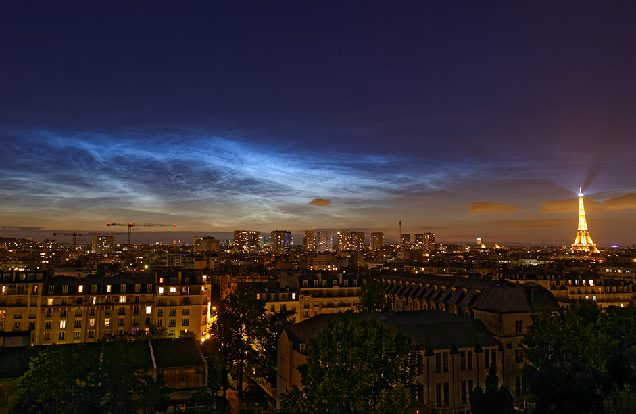It’s getting COLD in the mesosphere; so cold in fact, it’s causing noctilucent clouds (NLCs) to spill out of the Arctic and invade the mid-latitudes, dropping farther south than ever before.
This weekend, noctilucent clouds (NLCs) spilled out of the Arctic Circle to cover more than half of Europe.
Their electric-blue forms were observed as far south as the Italian Alps.
Photographer Bertrand Kulik was sitting on his balcony in District 15 of Paris, France when the clouds arrived on June 19 — this is what he saw:
[Bertrand Kulik]
[Bertrand Kulik]
“They were bright and beautiful,” says Kulik.
At one point, the noctilucent clouds extended more than 50 degrees above the horizon.
NLCs are clouds of frosted meteor smoke, explains Dr. Phillips. They form when summertime wisps of water vapor rise to the edge of space (~83 km high) and crystallize around disintegrated meteoroids.
For NLCs to form, extremely cold temperatures –as low as -150F– are required.
This frosted meteor smoke is always more prevalent during solar minimum conditions, when there is less solar energy heating the extreme upper atmosphere; and with the Sun still struggling to escape the grip of its deepest solar minimum of the past 100+ years, this goes someway to explaining these low latitude sightings.
But there is also a long-term upward trend, too:
(a) SBUV merged seasonal average IWC (ice water content) values for three different latitude bands:
50N-64N (purple triangles),
64N-74N (green crosses) and
74N-82N (blue squares).
The solid lines show multiple regression fits to the data for the periods 1979-1997 and 1998-2018.
(b) SBUV merged seasonal average IWC values for 50S-64S, 64S-74S, and 74S-82S. The solid lines show fits for the periods 1979-1997 and 1998-2018. (source).
Not all that long ago, NLCs were confined to the Arctic, but in recent years they’ve been spreading unusually-far south with sightings in London, Paris, Rome and Los Angeles as record cold penetrates the mesosphere:
Before 2018, no sightings of noctilucent clouds at the mid-latitudes existed. Then, from around mid-June 2019, NLCs were observed as far south as Joshua Tree, CA (34 deg. N) and Albuquerque, New Mexico (35 deg. N).
Last year (2020), these night shining clouds surprised Phil Halpert in London, England, who noticed a few electric-blue ripples over the rooftops on June 7:
“I’ve been waiting years to see NLCs, and finally it happened!” said Halpert.
“This is the first time I have ever seen noctilucent clouds over London!”
Observing tips: Dr. Phillips suggests you look west 30 to 60 minutes after sunset (or before sunrise) when the sun is just below the horizon. If you see luminous blue-white tendrils spreading across the sky, you may have spotted a noctilucent cloud.
Recommend this post and follow
The Life of Earth





No comments:
Post a Comment
Stick to the subject, NO religion, or Party politics